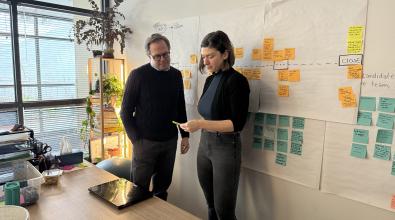Seattle & Syracuse set out to prove the power of procurement

Sometimes in city halls, changing the unsexy stuff is where innovators can make the biggest difference. That’s certainly true when it comes to reforming procurement.
Procurement is the often cumbersome way cities buy goods and services—everything from paper clips to sidewalk repairs to social services. All of it together can account for as much as a half of city budgets. By one estimate, cities around the world spent $6.4 trillion, or 8 percent of GDP, on such purchases last year.
At that scale, even small changes in city procurement practices can make a big difference—in cost savings, in delivering better services for residents, and in accomplishing ambitious city goals like building wealth in communities of color. At a historic moment when U.S. cities have billions of federal dollars to spend, the opportunities in transforming procurement from a box-checking exercise into a strategic function have never been greater.
As this movement builds, two U.S. cities—Seattle and Syracuse, N.Y.—will be ones to watch. With support from Bloomberg Philanthropies, these cities are poised to overhaul their procurement practices over the next two years and become models for other cities to learn from.
“City leaders don’t always think about procurement in a strategic way, but they should,” says Florence Juillard, who leads Bloomberg Philanthropies’ data programs. “We’re excited to see what Seattle and Syracuse can show the world about how to elevate the role of procurement in city hall and leverage their spending to deliver better and more equitable results for residents.”
In each city, the efforts will be driven by collaborations between city hall procurement staff and innovation teams supported by Bloomberg Philanthropies. On-the-ground support will come from the Harvard Kennedy School Government Performance Lab, or GPL, which is embedding a fellow to work alongside government innovators in each of the two cities starting this month. GPL’s experts, who have worked with cities around the world to implement a four-part framework for procurement excellence that includes a head-to-toe “extreme-procurement makeover,” are now offering that same support in Seattle and Syracuse.
“GPL fellows help cities diagnose problems and overcome barriers to change. With this support, a city can tackle all four pillars of procurement excellence,” says GPL Assistant Director Elena Hoffnagle. “We hope these cities will emerge absolutely best-in-class in procurement, and be examples for other cities to follow.”
[Read: Four ways to turn procurement into a force for change]
That effort will be supercharged by the i-teams’ deep expertise in using data and human-centered design to break down and solve problems from the perspectives of people who use a service. Those stakeholders are likely to include vendors, who often find the process of bidding on local government contracts confusing, as well as city staff, who struggle with paperwork and legal requirements on the other side of the transaction.
Reforming procurement “is a complex challenge that is ripe for i-teams and their design process,” says Justin Entzminger, Innovation Director for the Bloomberg Center for Public Innovation at Johns Hopkins University. The Bloomberg Center will provide staff in Syracuse and Seattle additional training in human-centered design, as well as support around product management and integrating digital tools into procurement.
Building generational wealth and equity
In Seattle, city leaders are building on a strong foundation for change. In one previous engagement with GPL, the city consolidated some 200 contracts for homeless services, freeing up staff time. They also shifted to a results-based approach: Instead of automatically renewing contracts based on compliance, the city re-bid $30-million worth of contracts for the first time in a decade and began tracking data on outcomes they wanted to see for the money.
Over the next two years, Seattle hopes to go much deeper into contracting for results. City leaders are also excited to pursue digital solutions for managing procurements. And they want to increase the amount of contracting the city does with women- and minority-owned businesses. Currently those businesses get about 20 percent of the city’s procurement dollars. That’s up substantially over the past decade, and city leaders think they can do a lot more.
“We see this as an opportunity to create generational wealth and create equity within the communities that have really suffered harm,” says Elisa Young, Equity and Policy Director for the Seattle Facilities & Administrative Services Department, which oversees procurement. “This is truly an opportunity to make sure that they are not only at the table, but they are here for the long haul.”
In total, Seattle spends almost $1 billion a year on goods and services. Innovation & Performance Director Leah Tivoli says it’s exciting to have the team working in an area with potential for such high impact. “What’s unique about this opportunity is taking the skills we have in data and design and orienting it toward a function that feels like it’s in the deep dark recesses of city government,” Tivoli says. “We want to illuminate procurement as a force for change.”
Syracuse is going in with similar goals of elevating the strategic importance of city purchasing. “Procurement tends to be a back-end administrative function,” says Chief Innovation & Data Officer Nicolas Diaz Amigo. “There’s lots of room to be innovative in how we procure stuff, to change the way we deliver services, and to get more out of our partnership with the private sector.”
Going digital
Like many cities, Syracuse is starting from a place where most contracting is handled on paper, using forms that haven’t been redesigned in decades. Recently, a pipe burst in City Hall’s contracts room, flooding the files—and also accelerating the push for change. The space was renovated in a way that can bring a handful of procurement staff together to work in one central place. Old files were thrown out, files to be kept were organized, and the case for going digital is clearer than ever.
In addition to better use of technology, one thing Budget Director Tim Rudd wants to see is for Syracuse to build a five-year procurement plan, similar to the long-term planning the city does around capital projects. That kind of forward planning, he hopes, can get staff thinking more strategically, and less reactively, about future contracts in the pipeline.
Rudd also wants to see Syracuse dramatically step up its efforts around contracting with women- and minority-owned firms. He cites an expensive highway removal project as an example of the opportunities. “We’re seeing all this public money potentially coming through with taking down Interstate 81,” he says. “If we’re going to spend a billion dollars taking down a highway, how do we make sure we have minority truckers hauling it away? We have to incorporate that into our projects so they can have a business started and be in position to get bigger work over time.”
Raising the bar
Other cities that have gone through GPL’s “extreme procurement makeover”— including Long Beach, Calif., and Tulsa, Okla.—have shown that dramatic change is possible.
For example, Long Beach was able to streamline processes in ways that cut the average cycle time for a contract from eight months to three. Now, 100 percent of the city’s service contracts have defined goals—up from 10 percent in just two years. The city also has stepped up outreach with vendors and put a lot of effort into writing clearer requests for proposals. That work resulted in a 114-percent jump in the number of vendors bidding on recent American Rescue Plan Act (ARPA) contracts, including large increases among women- and minority-owned businesses.
Long Beach and Tulsa show just the beginning of what's possible with procurement. What Syracuse achieves can provide a model for transformation in smaller cities. And Seattle can set a standard for larger cities with more resources and many contracts flowing through lots of different departments.
“Seattle has made major investments in better procurement and is already leading in a lot of ways,” Hoffnagle says. “So it’s a place for us to jointly think about the most innovative strategies out there that no one has ever tested when it comes to procurement. It’s on the cutting edge, and can be a laboratory to test new strategies that push the boundaries of procurement excellence.”


